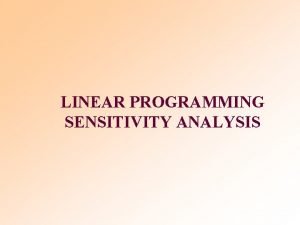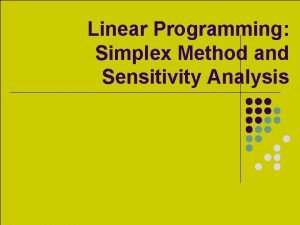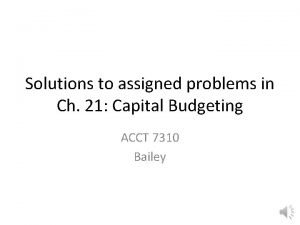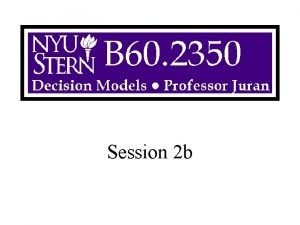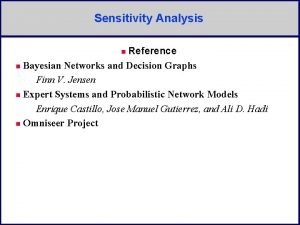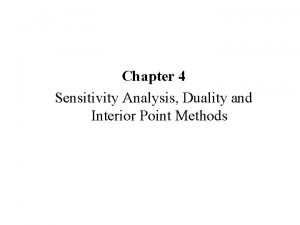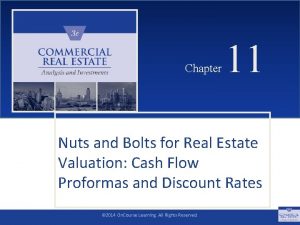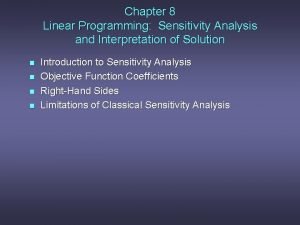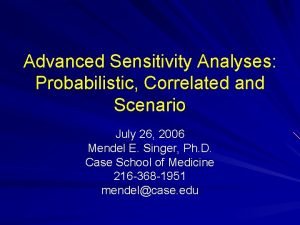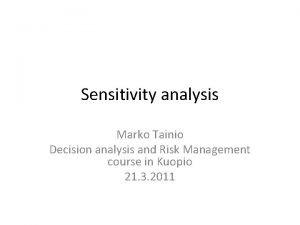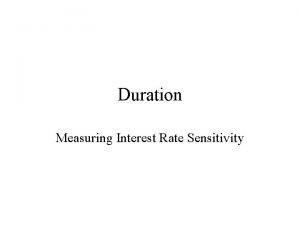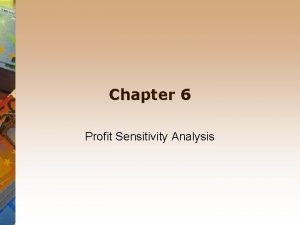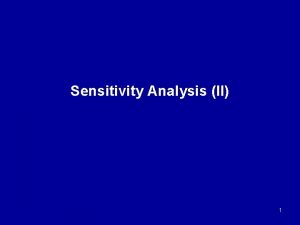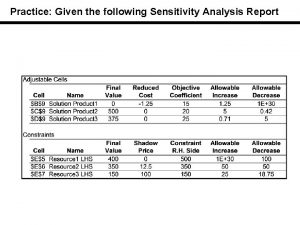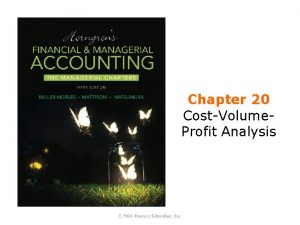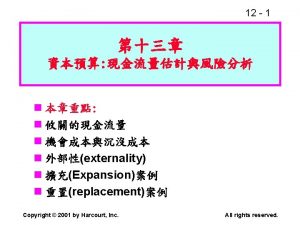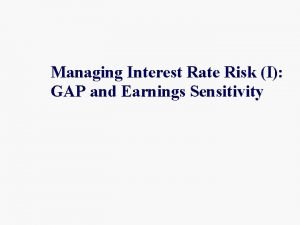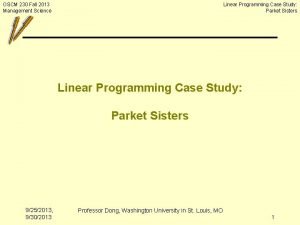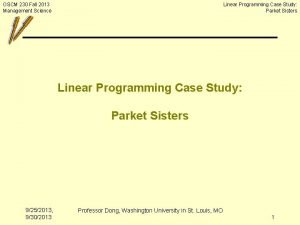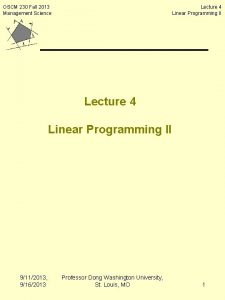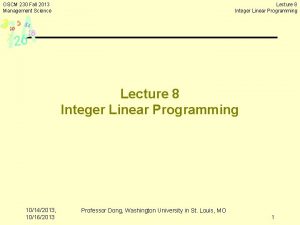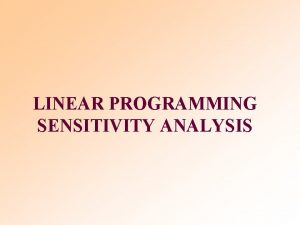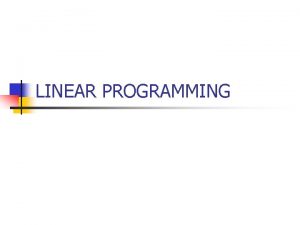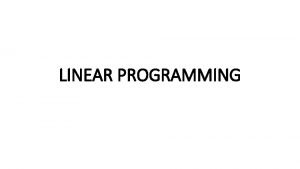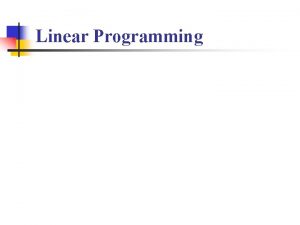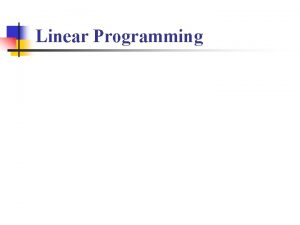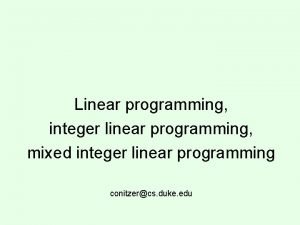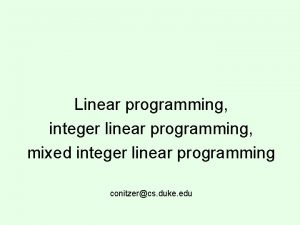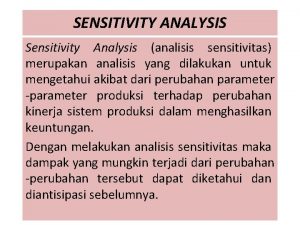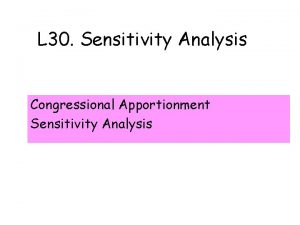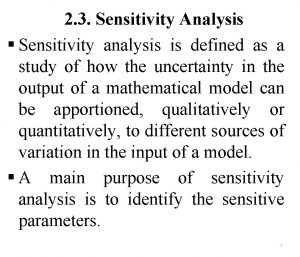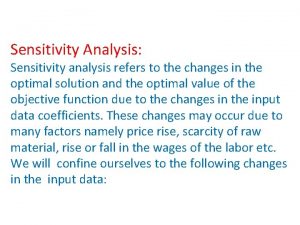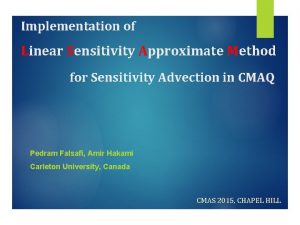Lecture 6 Linear Programming Sensitivity Analysis OSCM 230





















- Slides: 21

Lecture 6 Linear Programming: Sensitivity Analysis OSCM 230 Fall 2013 Management Science Lecture 6 Linear Programming Sensitivity Analysis 9/23/2013, 9/25/2013 Professor Dong Washington University in St. Louis, MO 1

OSCM 230 Fall 2013 Management Science Baseball Elimination 9/23/2013, 9/25/2013 Professor Dong Washington University in St. Louis, MO Lecture 6 Linear Programming: Sensitivity Analysis 2

OSCM 230 Fall 2013 Management Science Baseball Elimination 9/23/2013, 9/25/2013 Professor Dong Washington University in St. Louis, MO Lecture 6 Linear Programming: Sensitivity Analysis 3

OSCM 230 Fall 2013 Management Science Introduction Lecture 6 Linear Programming: Sensitivity Analysis • In general, we are never content with only the optimal solution to a linear program and want to acquire insight into the economics of the situation we are modeling • For example, we may want to know how sensitive our solution is to changes in the objective function or changes in some of the constraints. (Why? ) • Frequently, firms may want to invest in order to alleviate constraints: how exactly should a potential investment be allocated • Sensitivity analysis is vital to the intelligent use of any optimal LP solution 9/23/2013, 9/25/2013 Professor Dong Washington University in St. Louis, MO 4

OSCM 230 Fall 2013 Management Science Introduction Lecture 6 Linear Programming: Sensitivity Analysis • The first part of the lecture gives an “operational overview” of the most important concepts in sensitivity analysis. • In the first part, we’ll learn “how to” using Excel output • Then we’ll try to dig deeper and explore some of the “why” questions • For example, we’ll learn that sensitivity analysis offers a unique insight into the properties of the optimal solution of any linear program 9/23/2013, 9/25/2013 Professor Dong Washington University in St. Louis, MO 5

OSCM 230 Fall 2013 Management Science What is Sensitivity Analysis? Lecture 6 Linear Programming: Sensitivity Analysis The study of how changes in the parameters of a linear program affect the optimal solution (xi*) and the optimal objective function value Objective (OBJ) function: Change in coefficients MAX(MIN) c 1 x 1 + c 2 x 2 + c 3 x 3 + …. cn xn ST: A 11 x 1 + A 12 x 2 + A 13 x 3 + …. A 1 n xn ≤ (≥) B 1 A 21 x 1 + A 22 x 2 + A 23 x 3 + …. A 2 n xn ≤ (≥) B 2 A 31 x 1 + A 32 x 2 + A 33 x 3 + …. A 3 n xn ≤ (≥) B 3 ……… Am 1 x 1 + Am 2 x 2 + Am 3 x 3 + …. Amn xn ≤ (≥) Bm Constraints: Change in RHS constants xi's ≥ 0 or unrestricted in sign Professor Dong Washington University in St. Louis, MO 6

Lecture 6 Linear Programming: Sensitivity Analysis OSCM 230 Fall 2013 Management Science Why Sensitivity Analysis ? Analysis Real World Managerial Judgement Management Situation 9/23/2013, 9/25/2013 Intuition Results Interpretation Symbolic World Abstraction Model Sensitivity Analysis • Understand tradeoffs • Make quick adjustments • Build intuition Decisions Professor Dong Washington University in St. Louis, MO 7

OSCM 230 Fall 2013 Management Science Sensitivity Report in Excel Profit Contribution Maximize 10 x 1 + 9 x 2 Subject to: Cutting & Dyeing: 7/10 x 1 + x 2 ≤ 630 Sewing: 1/2 x 1 + 5/6 x 2 ≤ 600 Finishing: x 1 + 2/3 x 2 ≤ 708 Inspection & Packaging: 1/10 x 1 + 1/4 x 2 ≤ 135 Non-negative: x 1 ≥ 0 , x 2 ≥ 0 Lecture 6 Linear Programming: Sensitivity Analysis Optimal Solution: x 1=540, x 2=252 Optimal profit: 10*540+9*252 =7668 Sensitivity Report OBJ function related analysis Constraints related analysis 9/23/2013, 9/25/2013 8

Lecture 6 Linear Programming: Sensitivity Analysis OSCM 230 Fall 2013 Management Science Agenda • Example: Par Inc – Objective function: Change in coefficient • “allowable increase” and “allowable decrease” • “reduced cost” – Constraints: Change in right-hand-side constants • “shadow price” • “allowable increase” and “allowable decrease” – Simultaneous changes • “ 100% rule” • Summary 9/23/2013, 9/25/2013 Professor Dong Washington University in St. Louis, MO 9

Lecture 6 Linear Programming: Sensitivity Analysis OSCM 230 Fall 2013 Management Science Change in OBJ Function Coefficient Q 1. What if the unit profit of the deluxe bag is $10 instead of $9? What will happen to the optimal production plan and the optimal profit? 10 x 1 + 10 x 2 Max 10 x 1 + 9 x 2 Cutting & Dyeing 7/10 x 1 + x 2 ≤ 630 Sewing 1/2 x 1 + 5/6 x 2 ≤ 600 Finishing x 1 + 2/3 x 2 ≤ 708 Inspection & Packaging 1/10 x 1 + 1/4 x 2 ≤ 135 x 1 ≥ 0, x 2 ≥ 0, 10 -9 ≤ 5. 29 (the allowable increase of the coefficient of x 2 ) => Solution (540, 252) does NOT change New profit = old profit + (10 -9)× 252 = 7668+252=7920 10

Lecture 6 Linear Programming: Sensitivity Analysis OSCM 230 Fall 2013 Management Science “Allowable Increase” and “Allowable Decrease” in the “Adjustable Cells” Suppose Let • “Allowable” ranges tell you how much the coefficient of a given decision variable in the objective function may be increased or decreased without changing the optimal solution (the value of the decision variables xi*), where all other data are assumed to be fixed. • Calculate the new Objective Function Value (OVnew) – When Ci is within the “Allowable” range: xnew* =xold* – When Ci is outside the “Allowable” range: xnew* ≠ xold*, re-formulate LP and resolve! 9/23/2013, 9/25/2013 Professor Dong Washington University in St. Louis, MO 11

OSCM 230 Fall 2013 Management Science Change in OBJ Function Coefficient – Graphical Interpretation Lecture 6 Linear Programming: Sensitivity Analysis (540, 252) remains optimal as long as the objective function stays within the cone formed by the binding constraints (here finishing and cutting & dyeing are binding constraints) Iso-profit line (540, 252) 9/23/2013, 9/25/2013 Professor Dong Washington University in St. Louis, MO 12

OSCM 230 Fall 2013 Management Science Change in RHS Value of A Constraint – Shadow Price Lecture 6 Linear Programming: Sensitivity Analysis Q 2: What if an additional 10 hours of production time is available in cutting & dyeing? What will happen to the optimal production plan and the optimal profit? Max 10 x 1 + 9 x 2 Cutting & Dyeing 7/10 x 1 + x 2 ≤ 630 Sewing 1/2 x 1 + 5/6 x 2 ≤ 600 Finishing x 1 + 2/3 x 2 ≤ 708 Inspection & Packaging 1/10 x 1 + 1/4 x 2 ≤ 135 x 1 ≤ 0, x 2 ≤ 0, 7/10 x 1 + x 2 ≤ 640 - 630 = 10 ≤ 52. 36 (where 52. 36 is the allowable increase of RHS of C&D constraint) => New profit = Old profit +shadow price×RHS change = 7668 + 4. 375×(640 -630) = 7711. 75. 13

Lecture 6 Linear Programming: Sensitivity Analysis OSCM 230 Fall 2013 Management Science Interpretations of Shadow Price • Is the amount by which the objective function value changes given a unit increase in the RHS value of the constraint • represents the marginal value of resource, its marginal impact on the OBJ value assuming all other coefficients remain constant • • “Allowable Increase” and “Allowable Decrease” in Constraints “Allowable increase”= increase over which shadow price holds “Allowable Decrease” = decrease over which shadow price holds • Suppose • When Bj is within the “Allowable” range : shadow price can be used in the following way – OVnew = OVold + shadow price * ΔBj – For binding constraint: optimal solution will be different, re-formulate LP, and re-solve – For non-binding constraint: optimal solution will be the same. • When Bj is outside this “Allowable” range: cannot use the shadow price for changes outside the “Allowable” range , re-formulate LP, re-solve. Let

Lecture 6 Linear Programming: Sensitivity Analysis OSCM 230 Fall 2013 Management Science Effective Range for Shadow Price Effective range for shadow price is specified by “Allowable Increase” and “Allowable Decrease” of CONSTRAINTS Iso-profit line New Optimal Solution New C&D constraint Old Optimal Solution 9/23/2013, 9/25/2013 Old C&D constraint Professor Dong Washington University in St. Louis, MO 15

Lecture 6 Linear Programming: Sensitivity Analysis OSCM 230 Fall 2013 Management Science Change in OBJ Function Coefficient - Reduced Cost Q 3. Suppose we have the following golf bag problem: Max 10 x 1 + 6 x 2 Cutting & Dyeing 7/10 x 1 + x 2 ≤ 630 Sewing 1/2 x 1 + 5/6 x 2 ≤ 600 Finishing x 1 + 2/3 x 2 ≤ 708 Inspection & Packaging 1/10 x 1 + 1/4 x 2 ≤ 135 x 1≤ 0, x 2≤ 0, => Optimal solution: (708, 0) Q 3. What minimal unit profit should the deluxe bag generate in order to have positive production? Professor Dong Washington University in St. Louis, MO 16

Lecture 6 Linear Programming: Sensitivity Analysis OSCM 230 Fall 2013 Management Science Reduced Cost – Graphical Interpretation Reduced Cost of a product = difference between its marginal contribution to the OBJ function value and the marginal value of the resources it consumes Producing 1 unit deluxe bag consumes 10 x 1 + (20/3) x 2 =7080 10 x 1 + 6 x 2 =7080 Resource C&D: S: F: I&P: hr 1 5/6 2/3 ¼ Shadow price 0 0 10 0_______ The marginal value of the resources it consumes is 1*0+5/6*0 +2/3*10+1/4*0=20/3 The minimum unit profit of deluxe bag should be 20/3=6. 67 = (6+0. 67) in order to have positive production. The current unit profit of deluxe bag is 6. 9/23/2013, 9/25/2013 Therefore, reduced cost = 6 -20/3 = 2/3 = 0. 67, i. e. , producing 1 unit deluxe bag reduces profit by 0. 67.

OSCM 230 Fall 2013 Management Science Simultaneous Changes in Parameters Lecture 6 Linear Programming: Sensitivity Analysis 1. If all changes are in the objective function coefficients, then you can use the 100% rule. 2. If all changes are in the RHS values, then you can use the 100% rule. 3. If changes are in both the objective function and RHS, you must reformulate and re-solve! 4. If unsure, reformulate and re-solve! 9/23/2013, 9/25/2013 Professor Dong Washington University in St. Louis, MO 18

OSCM 230 Fall 2013 Management Science 100% Rule Lecture 6 Linear Programming: Sensitivity Analysis 1. For all changes that are made, sum the percentages of increase-changes with respect to (w. r. t. ) the corresponding “Allowable Increases” and the percentages of decreasechanges w. r. t. the corresponding “Allowable Decreases, ” in absolute values. 2. For simultaneous OBJ coefficient changes, if the sum of the percentage changes does not exceed 100%, the optimal solution will not change. 3. For simultaneous RHS changes, if the sum of the percentage changes does not exceed 100%, the shadow prices apply. 4. If the sum of the percentage changes DOES exceed 100%, then reformulate and re-solve! 9/23/2013, 9/25/2013 Professor Dong Washington University in St. Louis, MO 19

OSCM 230 Fall 2013 Management Science Simultaneous Changes Lecture 6 Linear Programming: Sensitivity Analysis Q 4. If the unit profit of the standard bag decreases to $8 and the unit of deluxe bag increases to $10, does the current production plan remain optimal? |10 - 8|/3. 7 + |10 -9|/5. 29 = 0. 7296 < 100% Production plan remains optimal New Profit = old profit +(8 -10)× 540 + (10 -9)× 252 = $6840 20

Lecture 6 Linear Programming: Sensitivity Analysis OSCM 230 Fall 2013 Management Science 9/23/2013, 9/25/2013 Professor Dong Washington University in St. Louis, MO 21
 Sensitivity analysis
Sensitivity analysis Sensitivity analysis simplex method
Sensitivity analysis simplex method Sensitivity analysis lecture notes
Sensitivity analysis lecture notes Perbedaan linear programming dan integer programming
Perbedaan linear programming dan integer programming Linear vs integer programming
Linear vs integer programming Programing adalah
Programing adalah 01:640:244 lecture notes - lecture 15: plat, idah, farad
01:640:244 lecture notes - lecture 15: plat, idah, farad Irr sensitivity analysis
Irr sensitivity analysis Decision models
Decision models Sensitivity analysis bayesian network
Sensitivity analysis bayesian network Sensitivity analysis and duality
Sensitivity analysis and duality Cap rate sensitivity analysis
Cap rate sensitivity analysis Sensitivity analysis and interpretation of solution
Sensitivity analysis and interpretation of solution Advanced sensitivity analysis
Advanced sensitivity analysis Cencsu
Cencsu Interest rate sensitivity analysis
Interest rate sensitivity analysis Profit sensitivity analysis
Profit sensitivity analysis Sensitivity report analysis
Sensitivity report analysis Sensitivity analysis report
Sensitivity analysis report Cvp sensitivity analysis
Cvp sensitivity analysis Scenario analysis中文
Scenario analysis中文 Interest rate risk sensitivity analysis
Interest rate risk sensitivity analysis
